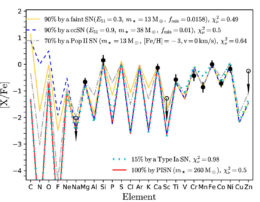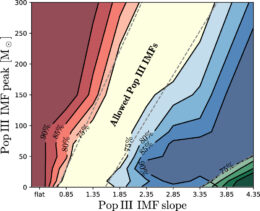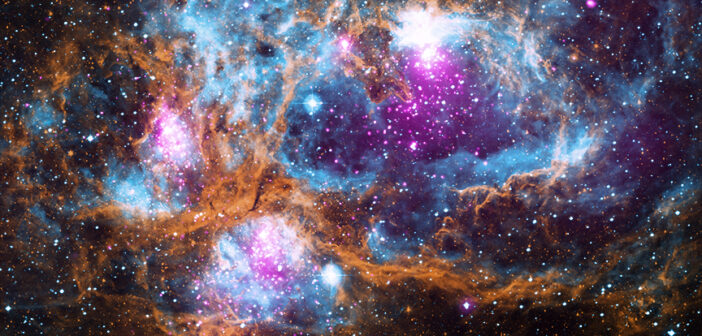The star J1010+2358 may have descended from just one of the first stars, which would make it a powerful probe of the elusive first generation of stars. However, new research finds that its properties are consistent with a range of stellar ancestries.
Seeking the First Generation of Stars
The first stars in the universe collapsed into being in clouds of pristine gas containing just hydrogen, helium, and a tiny amount of lithium. This simple set of chemical ingredients likely allowed the first generation of stars to attain enormous masses, although the exact distribution of their masses is unknown. These early stars created new elements in their cores and scattered them throughout the universe in expansive clouds of metal-enriched gas.

Measured chemical abundances for J1010+2358 (black circles) and model predictions for several different stellar ancestries. The prediction for a single 260-solar-mass ancestor is shown in red. Click to enlarge. [Adapted from Koutsouridou et al. 2024]
The star’s overall lack of metals (elements heavier than helium, in astronomer parlance) and curious chemical abundance pattern suggest that it was made from gas left behind by a 260-solar-mass star; J1010+2358 is especially lacking in elements with odd atomic numbers, such as sodium, compared to even-numbered elements. Now, a team led by Ioanna Koutsouridou (University of Florence) has investigated whether J1010+2358 is truly the descendant of a single, massive member of the first generation of stars.
A Study in Stellar Genealogy
Koutsouridou’s team examined whether J1010+2358 contains material passed down from only a single 260-solar-mass star, or if it contains material from several stars. Using chemical abundance modeling, the team found that J1010+2358 must have descended from a 260-solar-mass star — but it could have other stellar parents as well. In fact, without being able to measure several critical chemical elements in J1010+2358’s spectrum, it’s only possible to say that the reported stellar ancestor contributed at least 10% of J1010+2358’s metals.

Allowed and excluded initial mass functions based on the non-detection of single-ancestor stars in the Stellar Abundances for Galactic Archaeology database (red contours) and the properties of J1010+2358. The green and blue contours show the constraints placed by J1010+2358 if it inherited 70% or 90%, respectively, of its metals from a single star. [Koutsouridou et al. 2024]
The hunt for descendants of the first stars goes on: high-resolution surveys continue to dredge up stars with just one first-generation stellar ancestor, and future observations may fill in the missing elemental abundance measurements in J1010+2358’s spectrum and clarify its family tree.
Citation
“True Pair-instability Supernova Descendant: Implications for the First Stars’ Mass Distribution,” Ioanna Koutsouridou et al 2024 ApJL 962 L26. doi:10.3847/2041-8213/ad2466

